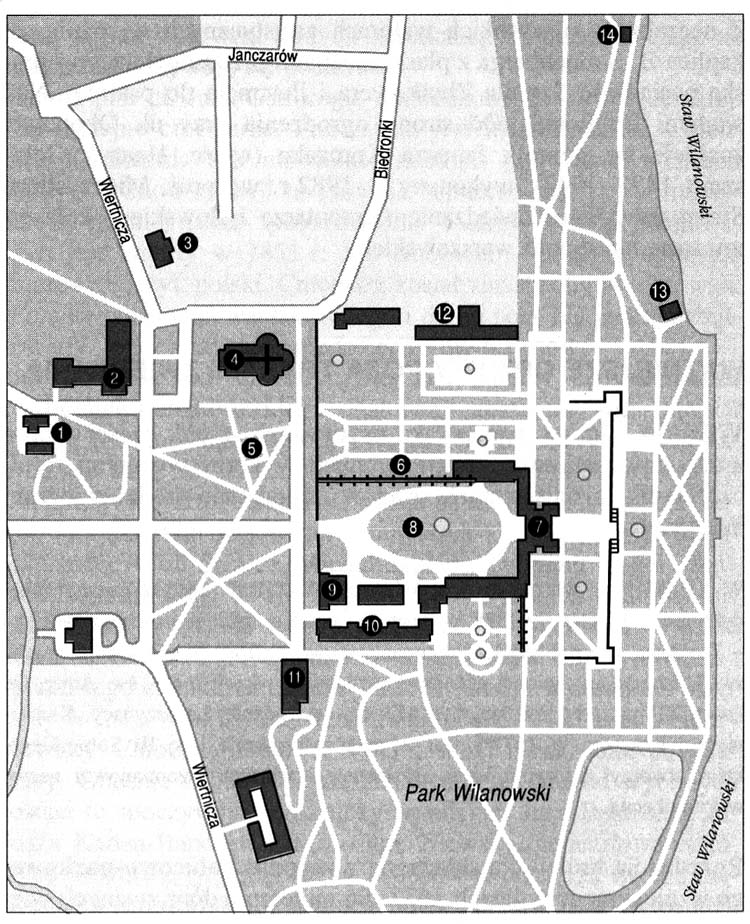 Wilanów – Plan – 1. Former inn – currently a cafe 2. Old inn – currently a restaurant 3. Former forge – currently a restaurant 4. Church of St. Anna 5. Potocki Mausoleum 6. Pergola 7. Palace 8. Guy Akademosa 9. Guards 10. Former palace kitchen 11. Former riding school – now the Poster Museum 12. Orangery 13. Pumping station building 14. Chinese arbor.
Wilanów – Plan – 1. Former inn – currently a cafe 2. Old inn – currently a restaurant 3. Former forge – currently a restaurant 4. Church of St. Anna 5. Potocki Mausoleum 6. Pergola 7. Palace 8. Guy Akademosa 9. Guards 10. Former palace kitchen 11. Former riding school – now the Poster Museum 12. Orangery 13. Pumping station building 14. Chinese arbor.
Wilanów. The Warsaw commune situated in the south of. parts of the city with residential buildings and land used for agriculture. One of the oldest settlements in the vicinity of medieval Warsaw.
W XII-XIII c. it was prince's property. W XIII c. was given to the Benedictines from Płock. From 1338 r. property of the Duke of Czersk and Sochaczew – Three days. From the middle of. XIII w. the mentioned existence of the parish and the chapel of. st. Leonard, later replaced by the wooden church of. st. Anna. From the end of the 14th century. the owners were the Milanówskis, later the Leszczyński family, Komornicki and Krzycki. W 1677 r. became the property of King Jan III Sobieski, who created his summer residence here and soon changed the name of the village to the present one.
The royal residence consists of a palace and park complex erected in the 1677-96 on the property then known as Milanowo. The palace was built on the foundations of the earlier building B.. Leszczyński in the early. 17th century. It was built in stages under the supervision of architect A.. W. lociego. First, the single-story part of the present palace was erected, later a half-floor and a gallery, and only in the final phase, the remaining elements giving the building the character of a baroque residence. The palace has an exceptionally rich exterior and interior decoration intended to emphasize the importance of its owners. In front of the building, there is an extensive honorary courtyard. W 1720 r. the palace became the property of the Sieniawski family, It was then that the residence was rebuilt and the late baroque wings were added (wg proj. G. Sweep). In years 1729-99 the owners of the palace were Czartoryscy and Lubomirscy. During this period, mainly the interior of the building was modernized. In years 1730-33 King August II of the Saxon leased the palace for life. At the end of the 18th century. to the south wing. a bathroom, a kitchen and a guardhouse were added. It was then that the palace garden was transformed into a sentimental English-Chinese park according to the design by. Szymon Bogumił Zug. W XIX w. the palace belonged to the Potocki family. On the initiative of Stanisław Kostka Potocki, the northern wing. the palace was added in the early. XIX w. neo-gothic gallery designed by. Christian Piotr Aigner. In years 1815-21 Chinese rooms covered with rich painting decorations were arranged. Park in the middle of. XIX w. re-arranged into an English landscape park. At the same time, the northern wing. was rebuilt in the neo-renaissance style. From 1892 do 1945 r. the palace was owned by the Branicki family. After the war, it became a museum (palace interiors, Polish portrait gallery, arts and crafts gallery, contemporary sculpture gallery – first as a branch of the National Museum, from 1995 r. as an independent institution under the name of the Wilanów Palace Museum) and residential (for official guests of the Polish government).
There are many architecturally and historically interesting buildings in the vicinity of the baroque residence. Parish Church. pw. st. Anna, erected in 1772 r. wg proj. Jan Kotelnicki, rebuilt in the neo-baroque style in the 1857-70. It is a three-nave building, with transept. The intersection of the nave and the transept is covered with a dome. The façade of the house is beautiful, tympanum and sculptures made by Warsaw artists F. Cenglera, A. Pruszynski and B.. Syrewicz. In the right chapel there are epitaphs of the Potocki and Branicki families buried in its vaults. Between the church and the palace gate is the mausoleum of Stanisław Kostka and Aleksandra Potocki, erected in 1836 r. wg proj. Henryk Marconi. It is decorated with sculptures by Jakub Tatarkiewicz. on the south. from the palace gate in the building of the former riding school and coach house 1968 r. there is one of the few institutions in the world collecting and exhibiting posters – Poster Museum. At the intersection of ul. Wilanowska i Wiertnicza there is a cemetery established in 1816 r., arranged on a circular plan with a neo-gothic chapel-mausoleum erected in 1823-26 wg proj. Christian Piotr Aigner.
